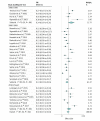Change in Mortality of Generalized Convulsive Status Epilepticus in High-Income Countries Over Time: A Systematic Review and Meta-analysis
- PMID: 31135807
- PMCID: PMC6547079
- DOI: 10.1001/jamaneurol.2019.1268
Change in Mortality of Generalized Convulsive Status Epilepticus in High-Income Countries Over Time: A Systematic Review and Meta-analysis
Abstract
Importance: Status epilepticus (SE) is associated with significant morbidity and mortality. Since the late 1990s, a more aggressive management of prolonged convulsive seizures lasting longer than 5 minutes has been advocated.
Objective: To determine if convulsive SE mortality has decreased during a time of increasing advocacy for out-of-hospital treatment and escalating and earlier treatment protocols for prolonged seizures and SE.
Data source: This systemic review and meta-analysis on studies focused on the mortality of convulsive status epilepticus was conducted by searching MEDLINE, Embase, PsychINFO, CINAHL Plus, and the Cochrane Database of Systematic Reviews between January 1, 1990, and June 30, 2017.
Study selection: Studies were excluded if they had fewer than 30 participants (<20 for refractory SE), were limited to SE of single specific etiology or an evaluation of a single treatment modality, or were studies of nonconvulsive SE.
Data extraction and synthesis: Data were abstracted and their quality was assessed via a modified Newcastle-Ottawa scale independently by 2 reviewers (A.N. and T.D.G.) using the Meta-analyses of Observational Studies in Epidemiology (MOOSE) guidelines. Data were pooled using a random-effects model.
Main outcomes and measures: The main outcome measure was in-hospital mortality or 30-day case fatality expressed as proportional mortality.
Results: Sixty-one studies were included in the analysis. The pooled mortality ratios were 15.9% (95% CI, 12.7-19.2) for adult studies, 13.0% (95% CI, 7.2-19.0) for all-age population studies, 3.6% (95% CI, 2.0%-5.2%) for pediatric studies, and 17.3% (95% CI, 9.8-24.7) for refractory SE studies, with very high between-study heterogeneity. We found no evidence of a change in prognosis over time nor by the definition of SE used.
Conclusions and relevance: The mortality of convulsive SE is higher in adults than in children and there was no evidence for improved survival over time. Although there are many explanations for these findings, they can be explained by aetiology of SE being the major determinant of mortality. However, there are potential confounders, including differences in case ascertainment and study heterogeneity. This meta-analysis highlights the need for strict international guidelines for the study of this condition.
Conflict of interest statement
Figures





Comment in
References
-
- Shorvon SD. Status Epilepticus: Its Clinical Features and Treatment in Children and Adults. Cambridge, England: Cambridge University Press; 1994. doi:10.1017/CBO9780511526930 - DOI

